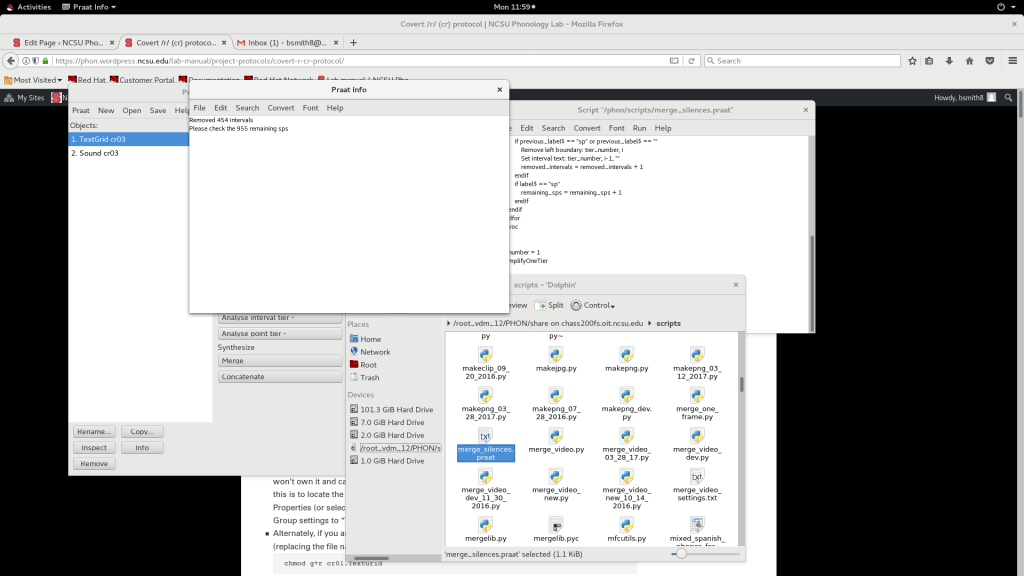

- #Script praat textgrid to csv how to
- #Script praat textgrid to csv update
- #Script praat textgrid to csv software
- #Script praat textgrid to csv download
Table of ContentsĪfter mastering the basic operation of Praat, you need to know how to run a script.

If there are any errors or problems, you can consult the email in the script. Please read the description of each script on this page before use.
#Script praat textgrid to csv download
If you are not familiar with this operation, you can directly download all the codes of this site by clicking, Code- Download ZIP, downloading all the files in this project.
#Script praat textgrid to csv update
If you are familiar with code and script operations, you can download, install, and configure github for windows on your computer to download the code to this machine through git clone, and update the code in time with the main website. 'o') then read this Textgrid into Praat as my Textgrid with every single wav file of 'dog' I open and only adjust the size of the interval containing oaccording to its place in the actual recording (ie. This part of the information comes from ( )。 How to use Praat-Scripts code on github for each batch, create one Textgrid / text file with the relevant vowel transcription (e.g. The authors of Praat are Professor Paul Boersma and Assistant Professor David Weenink, chair of the Institute of Speech Science, Faculty of Humanities, University of Amsterdam, the Netherlands.
#Script praat textgrid to csv software
As the name of the software, it is translated into Praat Phonetics Software for simplicity. Praat means talking or talking in Dutch, and doing phonetics by computer means using computers to study phonetics. I hope to be helpful to the experimental phonetics beginners who get started with Praat, and more practical Praat scripts are being updated continuously. How to use these parameters to make a simple tone and intonation map.Use Praat to extract the main acoustic parameters, duration, fundamental frequency, formant selectObject: getTextGrid.textgrid: Save as text file: getTextGrid.path removeObject: getTextGrid.Praat operations on specific label information, such as tier, interval, including replacement, addition, delete, etc.Operation of Praat on files, including annotation file TextGrid and audio file wav.The two loops inserted above could have been replaced with calls to and (full disclosure: I wrote that plugin).This project includes some commonly used scripts of Praat, combined with simple examples to explain how to use these scripts, each independent directory contains sample files and result files, which are suitable for those who have some understanding of the basic operations of Praat, beginners who have a good understanding of basic acoustic parameters such as Duration, fundamental frequency and formant. # If you knew beforehand what objects to select,Īs an aside, the selection plugin available through CPrAN was written to make it easier to manage Praat object selections for cases such as this. # Select all the objects you want to remove # Save the ID numbers of the currently selected intervals Textgrid = To TextGrid (silences): -35, 0.1, 0.05, silent, sounding I changed some variable names to make it easier to follow. This might sound obvious, but you can save the ID numbers of the multiple extracted intervals by saving each of them into an indexed variable, and then re-selecting them when you need to remove them.īelow you'll find an edited and commented version of your script. Shameless plug: it might be overkill, but you might want to take a look at some of the CPrAN plugins, some of. This should also be more efficient, as you are reducing the number of times you are writing to disk, which is slow. Although I could still run it like that my directory would be flooded and I do not think this is elegant. Edit file (as many times as you need, as a Praat object, not saving to disk) Save file. Therefore later on I do not have a reference to remove it from my object directory. However because this line produces more that one variable I cannot save it. Variables Selecting objects String concatenation Comments Whitespace For-loops + if else statements Syntax Regex Some Basics. Then I use concatenate immediately to create the desired file and select it. Audio file TextGrid Text file Output: Audio file TextGrid Text file Write summary and pseudo code. In this line the parts that contain sound are extracted and selected. 35 0.1 0.05 'silent' 'sounding'Įxtract intervals where: 1, "no", "contains", "sounding"Īlthough I get what I want my problem is in the line Extract intervals where: 1, "no", "contains", "sounding" I have created this script that I will put in a for loop. I try to create a script in praat that will go through some objects in my object list with a for loop and will remove silent intervals.

I am new to praat, so maybe this is an easy question.


 0 kommentar(er)
0 kommentar(er)
